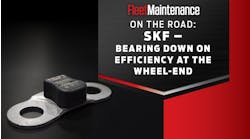Bridgestone Americas, Inc. announced the Bandag B123 FuelTech retread, a trailer retread designed to uniquely complement the Bridgestone R123 Ecopia tire in design and performance to help fleets reduce fuel cost. Through an innovative rib design, the Bandag B123 retread is engineered to fight irregular wear and enable longer tread life for fleets.
“The majority of a fleet’s fuel savings come from the drive and trailer tire positions, so we designed the Bandag B123 FuelTech retread to pair with Bridgestone Ecopia tires to maximize fleet savings,” said Keith Iwinski, director of marketing, Bandag, U.S. and Canada, Bridgestone Americas Tire Operations. “Our fleet customers expect to optimize their tire investment with premium performance and extended tire life, which is why Bridgestone is committed to making mobility more efficient through new, innovative technologies, products, and service.”
The Bandag B123 FuelTech retread is engineered to reduce energy loss by 4.7 percent for optimal fuel efficiency when combined with the Bridgestone R123 Ecopia tire1. With an optimized tread design, the Bandag B123 FuelTech retread is engineered to deliver a 5 percent improvement in wear performance compared to Bandag B197 FuelTech2. The Bandag B123 FuelTech retread features a new rib design to fight irregular tire wear and promote longer tread life.
When used together, the Bandag B123 FuelTech retread and Bridgestone R123 Ecopia trailer tire can reduce energy loss by 4.7 percent and optimize fuel efficiency. By switching to the B123 FuelTech retread, fleets can save up to $165,900 in fuel costs3.
Bridgestone created its Ecopia tire line to offer fleets tire solutions with retreadability benefits engineered with new casing technology to lower rolling resistance and extend treadwear, in addition to meeting SmartWay-verification and California Air Resources Board (CARB) compliance. When fleets use Bridgestone Ecopia tires in all positions, they save an estimated $1,393 annually per truck4.
- Comparison based on Bandag B123 tread with R123 casing versus Bandag B197 tread with R197 casing. Results may vary.
- Comparison based on Bandag B123 FuelTech versus Bandag B197 from Bridgestone internal TLCC model which incorporates third party SAE J1269 rolling resistance testing and measures results over the life of the tire. Savings calculated assuming Bridgestone R123 casing, $3.00 average price of fuel, 5/32nds pull point, 80,000 lbs total vehicle weight, for a Class 8 tandem-drive axle tractor and single trailer combination traveling 120,000 miles/year. Results may vary.
- Comparison based on Bandag B123 FuelTech versus Goodyear G316 Fuelmax from Bridgestone internal TLCC model which incorporates third party SAE J1269 rolling resistance testing and measures results over the life of the tire. Savings calculated assuming Bridgestone R123 casing, $3.00 average price of fuel, 5/32nds pull point, 80,000 lbs total vehicle weight, for a Class 8 tandem-drive axle tractor and single trailer combination traveling 120,000 miles/year. Results may vary.
- Bridgestone R283A Ecopia (in steer position), M710 Ecopia (in drive position), and R197 Ecopia (in trailer position) in size 295/75R22.5 load range G, compared to the equivalent size and load range of Michelin X-Line Energy Z (in steer position), X-Line Energy D (in drive position), and X-Line Energy T (in trailer position). Rolling resistance and wear results obtained from Bridgestone internal TLCC model which incorporates third party SAE J1269 rolling resistance testing and measures results over the life of the tire. Savings calculated assuming $3.00/gallon fuel cost, 5/32nds pull point, 80,000 lbs total vehicle weight, for a Class 8 tandem drive axle tractor and single trailer combination traveling 120,000 miles/year. Projected wear results based on field test data across multiple users in long haul fleet application. Actual results will vary depending on several factors such as tire size, operating conditions, maintenance, road conditions, and driving style.



